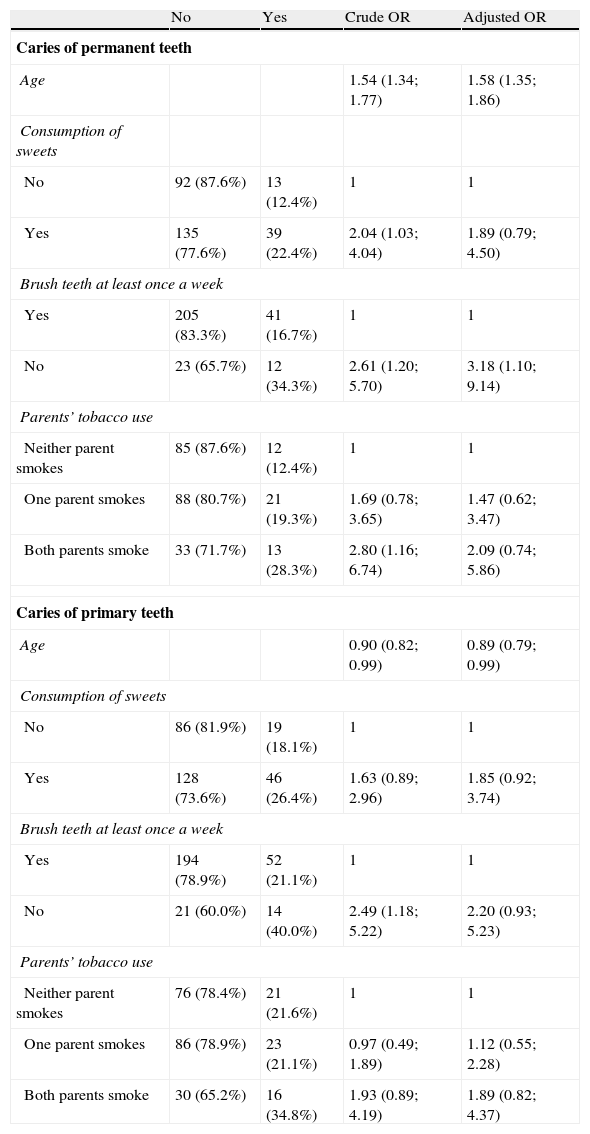In 1986, the report of the US Surgeon General and the National Research Council showed the available evidence about the adverse effects of passive exposure to tobacco smoke and health in children.1 Later reports identified more effects of second-hand smoke in children and indicated that this exposure was the cause of numerous consequences in exposed children.2
There is conclusive evidence of the relationship between the passive exposure to tobacco smoke and the presentation of respiratory symptoms.3,4 We present in this study the increased risk for dental caries in both primary as well as permanent teeth in children whose parents are smokers.
In a sample of 281 children aged 5–14 who were seen consecutively in a primary care center and in whom we initially were studying the relationship between the presence of caries with dental hygiene and dietary habits,5 we would like to show the results that we have found with regards to the exposure to parental tobacco smoke and the presence of caries in their children. The dental examination was done by two dentists in accordance with the methodology of the World Health Organization. By means of structured questionnaires, we determined the frequency of brushing, consumption of sweets and tobacco use of the children's parents. After the descriptive study, a multivariate logistic regression analysis was done, using the presence or absence of caries as a dependent variable, both in primary as well as in permanent teeth. Table 1 demonstrates that the prevalence of caries in the univariate analysis increases progressively as tobacco habit increases among the parents of the children, going from 12.4% in children whose parents do not smoke to 28.3% if both parents smoke, in permanent teeth. The same phenomenon is observed in primary teeth, going from 21.6% to 34.8%. After the multivariate analysis, adjusting for age, consumption of sweets, frequency of brushing and exposure to second-hand smoke, a progressive increase in the risk for caries is observed, which, although did not reach statistical significance, is consistent with studies that show the increase in the risk for caries with the exposure to tobacco smoke.6 These data suggest a dose–response effect between the tobacco habit of the parents and the probability of having caries consistent with what is known regarding physiopathological mechanisms of and their biological plausibility.
Presence or absence of caries in permanent and primary teeth, according to different variables.
| No | Yes | Crude OR | Adjusted OR | |
| Caries of permanent teeth | ||||
| Age | 1.54 (1.34; 1.77) | 1.58 (1.35; 1.86) | ||
| Consumption of sweets | ||||
| No | 92 (87.6%) | 13 (12.4%) | 1 | 1 |
| Yes | 135 (77.6%) | 39 (22.4%) | 2.04 (1.03; 4.04) | 1.89 (0.79; 4.50) |
| Brush teeth at least once a week | ||||
| Yes | 205 (83.3%) | 41 (16.7%) | 1 | 1 |
| No | 23 (65.7%) | 12 (34.3%) | 2.61 (1.20; 5.70) | 3.18 (1.10; 9.14) |
| Parents’ tobacco use | ||||
| Neither parent smokes | 85 (87.6%) | 12 (12.4%) | 1 | 1 |
| One parent smokes | 88 (80.7%) | 21 (19.3%) | 1.69 (0.78; 3.65) | 1.47 (0.62; 3.47) |
| Both parents smoke | 33 (71.7%) | 13 (28.3%) | 2.80 (1.16; 6.74) | 2.09 (0.74; 5.86) |
| Caries of primary teeth | ||||
| Age | 0.90 (0.82; 0.99) | 0.89 (0.79; 0.99) | ||
| Consumption of sweets | ||||
| No | 86 (81.9%) | 19 (18.1%) | 1 | 1 |
| Yes | 128 (73.6%) | 46 (26.4%) | 1.63 (0.89; 2.96) | 1.85 (0.92; 3.74) |
| Brush teeth at least once a week | ||||
| Yes | 194 (78.9%) | 52 (21.1%) | 1 | 1 |
| No | 21 (60.0%) | 14 (40.0%) | 2.49 (1.18; 5.22) | 2.20 (0.93; 5.23) |
| Parents’ tobacco use | ||||
| Neither parent smokes | 76 (78.4%) | 21 (21.6%) | 1 | 1 |
| One parent smokes | 86 (78.9%) | 23 (21.1%) | 0.97 (0.49; 1.89) | 1.12 (0.55; 2.28) |
| Both parents smoke | 30 (65.2%) | 16 (34.8%) | 1.93 (0.89; 4.19) | 1.89 (0.82; 4.37) |
Please cite this article as: Pita-Fernández S, et al. Exposición pasiva al tabaco y caries dental de los niños. Arch Bronconeumol. 2011;47:419–20.











